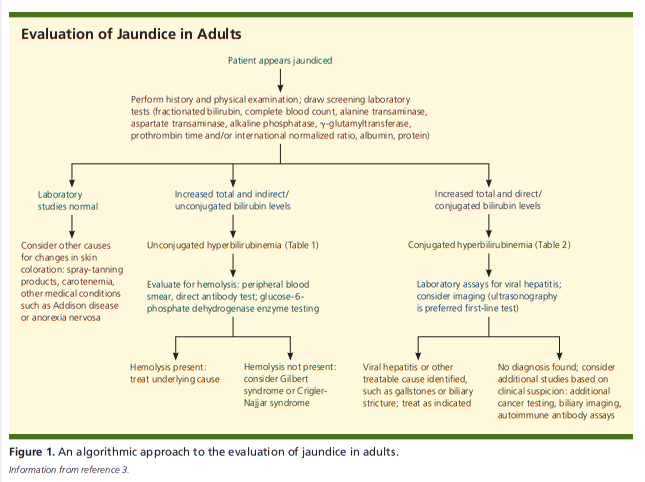In addition to the AFP article discussed below, here is a link to ARUP Consult:
ARUP Consult® is a laboratory test selection support tool with more than 2,000 lab tests categorized into disease-related topics and algorithms.
Jaundice can be caused by liver disease or hemolysis. And here are links to the laboratory evaluation of these two topics from ARUP Consult:
- Liver Disease Evaluation
- “Liver disease diagnosis can generally be made using a carefully obtained history, physical examination, and a few laboratory tests. Initial laboratory testing should include aspartate aminotransferase (AST), alanine aminotransferase (ALT), alkaline phosphatase (ALP), and total bilirubin.”
- Hemolytic Anemias
- “Hemolytic anemias, which result from premature destruction of red blood cells (RBCs), 1 may be hereditary or acquired. Hemolytic anemias can be due to numerous causes, including RBC membrane disorders, RBC enzyme defects, immune conditions, hemoglobinopathies, and thrombotic microangiopathies, among other causes (see Classification section). 1″
- “Common hemolytic anemias include glucose-6-phosphate dehydrogenase (G6PD) deficiency, pyruvate kinase (PK) deficiency, and hereditary spherocytosis. Laboratory testing includes an initial evaluation for hemolysis, secondary testing to determine the etiology of hemolytic anemia, and, in some cases, molecular testing to confirm the diagnosis or determine recurrence risk.
In this post I link to and excerpt from Evaluation of Jaundice In Adults [PubMed Abstract] [Full Text HTML] [Full Text PDF]. Am Fam Physician. 2017 Feb 1;95(3):164-168.
First I list the diagnostic schema from the article and then I excerpt additional resources from the article.
Here is the diagnostic schema:








